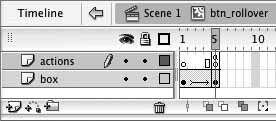Section 4.5. More Fun with Buttons
4.5. More Fun with ButtonsIn the last section, you learned how to create a generic button that promotes reusability. Next, you'll carry that notion forward by creating invisible buttons that can be used to add "hot spots" to just about anything, and by learning how to spice up your buttons with animation. 4.5.1. Invisible ButtonsIn some cases, you want the ability to freely place interactive hot spots throughout a project, without having to go to a lot of trouble to create many different buttons. For example, think of a large or complex illustration in which you want to trigger the display of detail views, or a block of text that should display definitions for certain words. Finally, imagine a quiz that requires you to click the correct detail in an image. In these cases (and many more), it would be difficult to have to create a separate button for every interactive location. However, the generic button you created earlier wouldn't work either, because it would cover the material you want to be visible as a button. This is where invisible buttons can be very handy. Invisible buttons are merely normal buttons with no Up, Over, or Down state. Only a Hit state exists, to define the area that should respond to the mouse. Try to make one now:
If the button is invisible, why can you see it? Well, it wouldn't be very convenient if you couldn't ever see the button. Flash will automatically create a translucent blue area that represents the button's shape (as defined by the Hit state), which is visible only in authoring mode. When you test your movie, you will not see the button at runtime, but you will see the requisite cursor feedback to show the button is functioning. If you want to see an example of how invisible buttons work, look at the invisible_buttons.fla file in your 04 directory. 4.5.2. Animated ButtonsAnimated buttons can be created a number of ways, but in this project you'll look at the simplest. You'll build an animated button by creating an animation sequence within a movie clip and then simply adding that movie clip to a button's timeline:
The rectangle begins short and increases in height from its center point. The stop() command stops the animation at frame 5. Figure 4-14 shows the timeline of the animation. Figure 4-14. The btn_rollover symbol's timeline Now you will nest the movie clip inside a button:
As planned, when you roll over the "about us" text, the corresponding button's hit area is triggered, its Over state displays, and the animated movie clip on that frame begins to play. When you roll out, the animation disappears. 4.5.3. What's Next?Finally, your Flash movies are starting to include some interactivity. From here on, you'll build more and more functionality into your movies, and this chapter should better prepare you for what's coming. To get some practice adding ActionScript to buttons, try coding the buttons in the animated_buttons.fla file to go to various web sites. As you gain more experience, you can mimic button behavior using movie clips for even more creative freedom. For more information, check out Sham Bhangal's Flash Hacks (O'Reilly)specifically, Hack #63, "Button Movie Clips." Also, visit some of your favorite Flash sites to see how other developers design their buttons. Does animation in a button contribute to the overall look of the site, or does it distract you? How do animated buttons integrate with the site's design to blend in with it? Studying the work of other Flash designers is a wonderful way to get ideas. Learn what you can about how elements in site designs work together to create a cohesive look. Specifically, study when Flash is used and, even more so, when Flash is not used. Many sites benefit from integrating Flash with other HTML content rather than using Flash exclusively. In the next chapter, you'll begin working with bitmaps. You'll learn how to:
|
EAN: 2147483647
Pages: 117
- Challenging the Unpredictable: Changeable Order Management Systems
- ERP System Acquisition: A Process Model and Results From an Austrian Survey
- Context Management of ERP Processes in Virtual Communities
- Distributed Data Warehouse for Geo-spatial Services
- Relevance and Micro-Relevance for the Professional as Determinants of IT-Diffusion and IT-Use in Healthcare
- Assessing Business-IT Alignment Maturity
- Linking the IT Balanced Scorecard to the Business Objectives at a Major Canadian Financial Group
- Measuring and Managing E-Business Initiatives Through the Balanced Scorecard
- A View on Knowledge Management: Utilizing a Balanced Scorecard Methodology for Analyzing Knowledge Metrics
- Governance Structures for IT in the Health Care Industry